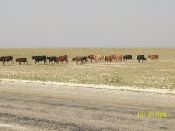| Study site contexts & goals: local desertification extent and impact |
 |
|
Research theme coordinator: ISRIC – World Soil Information ... in collaboration with all the study site teams:
Across the globe all areas prone to desertification have some similar features. Without the buffer of abundant rain or deep soils, agriculture tends to be more vulnerable to water availiabilty and care needs to be taken that any land use activity does not impoverish the land and reduce its productivity. However, to some extent, each area also responds uniquely to the threat of desertification. Responses depend on the details of the local soil type, topography and climate; on the social, economic and land use history; on the goals that the local people have for the future of their area; and of course on how degraded the land has already become.
The DESIRE project worked in 18 such similar but unique areas (we called them study sites), with the objective of identifying in each sustainable land management strategies that are tailored to their particular local context and goals.
This research theme sets the scientific work of DESIRE within the context of the existing body of knowledge, and examines the particular local context of each study site.
|
||||||||||||||||

Acknowledgement
The DESIRE project was
|
DESIRE brought together the expertise of
26 international research institutes
and non-governmental organisations.
This website does not necessarily
represent the opinion of the
European Commission. The European
Commission is not responsible for
any use that might be made of the
information contained herein. 
 1. Study site contexts & goals
1. Study site contexts & goals



